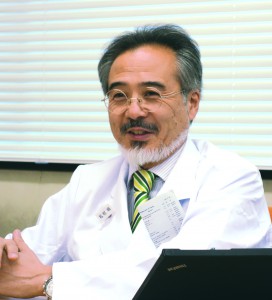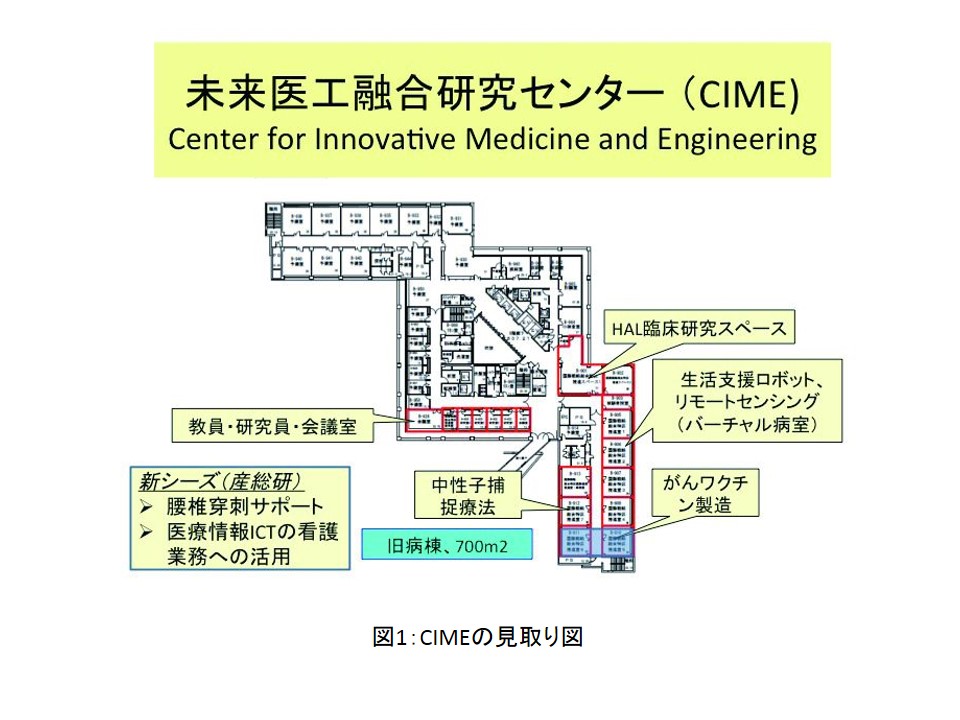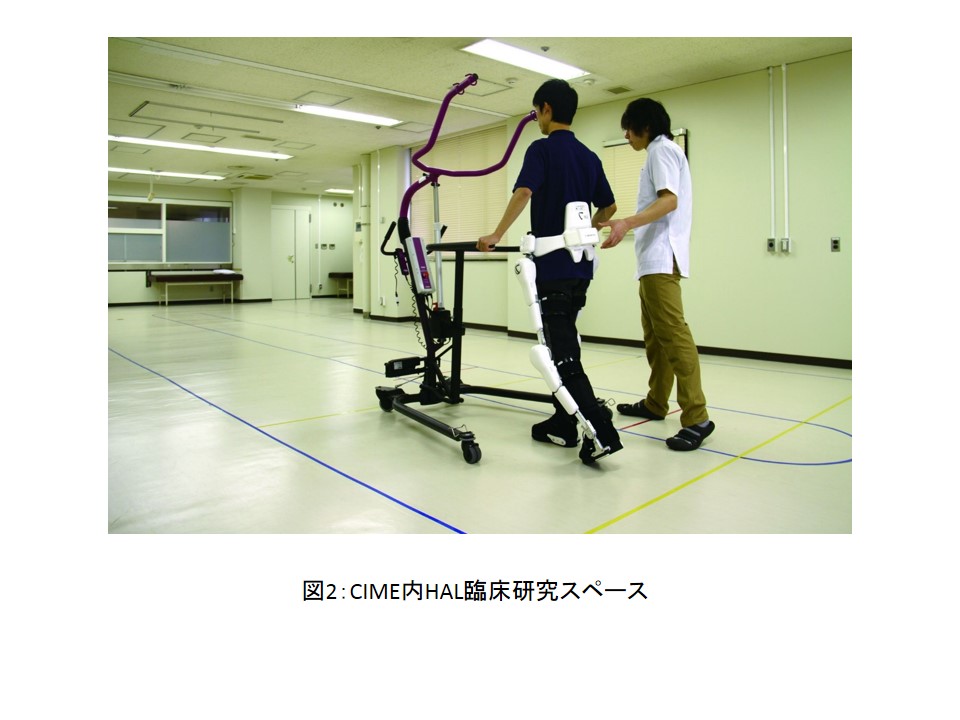キーワード:再生医療、幹細胞、drug delivery system、生体内イメージング、実用研究
http://sanlab.kz.tsukuba.ac.jp/?page_id=51
http://neurosurgery-tsukuba.com/
 脳卒中などの病気や、事故によるケガで神経が損傷してしまうと、思うように体を動かせない、感覚が麻痺して熱さ・冷たさを感じにくい、といった症状が出ることがあります。そのような症状が残ってしまうと、患者さんの日常生活に暗い影を落とすことになります。本リサーチユニットでは、医療技術と、ロボット工学による身体機能支援システムを組み合わせた新しい治療法を研究開発し、病気やケガによって失われた身体機能の復活を目指しています。
脳卒中などの病気や、事故によるケガで神経が損傷してしまうと、思うように体を動かせない、感覚が麻痺して熱さ・冷たさを感じにくい、といった症状が出ることがあります。そのような症状が残ってしまうと、患者さんの日常生活に暗い影を落とすことになります。本リサーチユニットでは、医療技術と、ロボット工学による身体機能支援システムを組み合わせた新しい治療法を研究開発し、病気やケガによって失われた身体機能の復活を目指しています。
医学からロボット工学まで、幅広い分野の研究を統合して神経機能再建にとりくむ
病気やケガによって損傷した神経機能の回復には、神経再生研究の推進と同時に、再生した神経が適切な機能を獲得するための方法・技術の確立が必要です。そのため、私たちは基礎・臨床医学、看護学、認知・知能工学、ロボット工学など幅広い分野を統合して研究開発を行なっています。具体的には、血管内皮前駆細胞を用いた脳卒中治療法の研究開発や、現在脳卒中に使われている薬の効能を上げるためのDDS *1研究開発、そしてロボット工学による身体機能支援システムの研究開発をすすめています。

実証研究を行なう病院内拠点
私たちは、医学・工学の研究成果を病院で実証研究する拠点として、筑波大学附属病院内に「CIME(未来医工融合研究センター)」を整備中です(図1)。 この拠点には、脳卒中で入院中の患者さんや、脊髄損傷などで思うように体を動かせない患者さんを対象に、ロボットスーツ(HAL*3)を使ったリハビリの治験を行なう場があります(図2)。また、がんワクチンなどを製造する場もあるため、ここで製造したがんワクチンなどを学外の医療機関へ提供できるように なります。さらに、ベッドの下にセンサーをつけて、患者さんの異常な動きをナースステーションでとらえて、事前に転倒などのケガを防ぐしくみについて実証研究を行なう場もあります。これらの研究の成果により問題を発見・解決し、将来的に実際の医療現場で使用していく予定です。
*1:Drug Delivery System の略。薬を目的の患部へ集中的に運ぶ技術のこと
*2:Center for Innovative Medicine and Engineering の略
*3:Hybrid Assistive Limb の略

社会への貢献・実績
● 細胞療法の基礎的・臨床的研究による医療応用
● DDSの基礎的・臨床的研究による医療応用
● HALなどのロボット工学的支援システムの実用化研究
● ニューロモデュレーションによる身体機能向上システムの研究開発
● ヒューマン・コミュニケーションを介した機能再建の研究開発
● 最先端の画像診断による機能評価システムの研究開発
(取材:平成25年11月22日)
Recovering from Neurological Impairment due to Disease or Injury
Unit members : Ishikawa Eiichi Masumoto, Tomohiko Ohneda, Osamu Nakai, Kei Tanaka, Fumihide Hidaka, Kikue Suzuki, Kenji
Key words: regenerative medicine, stem cells, drug delivery systems, in-vivo imaging, translational research, medical robot
Neurological damage due to disease, such as stroke, or accident-related injury occasionally involves symptoms, such as difficulties in voluntarily moving the body and tactile sensation. If these symptoms persist, they may negatively influence patients’ daily activities. This research unit aims to recover the  neurological function impaired due to disease or injury by researching and developing new treatment methods combining medical technologies and robotics-based assistive systems for the physical function.
neurological function impaired due to disease or injury by researching and developing new treatment methods combining medical technologies and robotics-based assistive systems for the physical function.
Widely integrating research areas from medical science to robotics
In order to recover the neurological function impaired due to disease or injury, it is necessary to establish methods and techniques to allow regenerated nerves to appropriately function, in addition to actively conducting regenerative medicine research. In line with this, we promote research and development widely integrating research areas from basic to clinical medicine and nursing to cognitive/intellectual engineering and robotics. For example, we are currently engaged in R&D activities to establish a new method to treat stroke using endothelial progenitor cells, DDS*1, to enhance the effectiveness of conventional stroke treatment drugs, and robotics-based assistive systems for the physical function.
CIME*2 – A In-hospital Base for Empirical Research
As a base for in-hospital empirical research to examine the outcomes of medical and engineering studies, the Center for Innovative Medicine and Engineering (CIME) is currently being organized within University of Tsukuba Hospital (Figure 1). In this center, there is a section to conduct clinical trials as part of the development of rehabilitation methods using robot suits (HAL*3) for stroke inpatients and those with physical limitations due to spinal cord injury (Figure 2). Another section is allocated to cancer vaccine production. The cancer vaccines produced here will be supplied to external medical institutions. The center also consists of a section conducting empirical research to examine mechanisms to prevent injury, such as falls, by detecting patients’ abnormal movements at the nurse station, with a sensor placed under the bed. The outcomes of these studies will be used to identify and resolve problems, and be applied to clinical practice in the future.

Figure 2: Section for HAL-related clinical research in CIME
*1: Drug delivery systems: techniques to selectively deliver drugs to targeted sites in the body
*2: The Center for Innovative Medicine and Engineering
*3: Hybrid assistive limb
Social contributions and achievements
●Clinical applications of the outcomes of basic and clinical studies on cell therapy
●Clinical applications of the outcomes of basic and clinical studies on DDS
●Research for the practical application of robotics-based assistive systems, such as HAL
●Research and development for neuromodulation-based physical function improvement systems
●Research and development for functional reconstruction through human communication
●Research and development for functional assessment systems adopting the latest diagnostic imaging techniques

